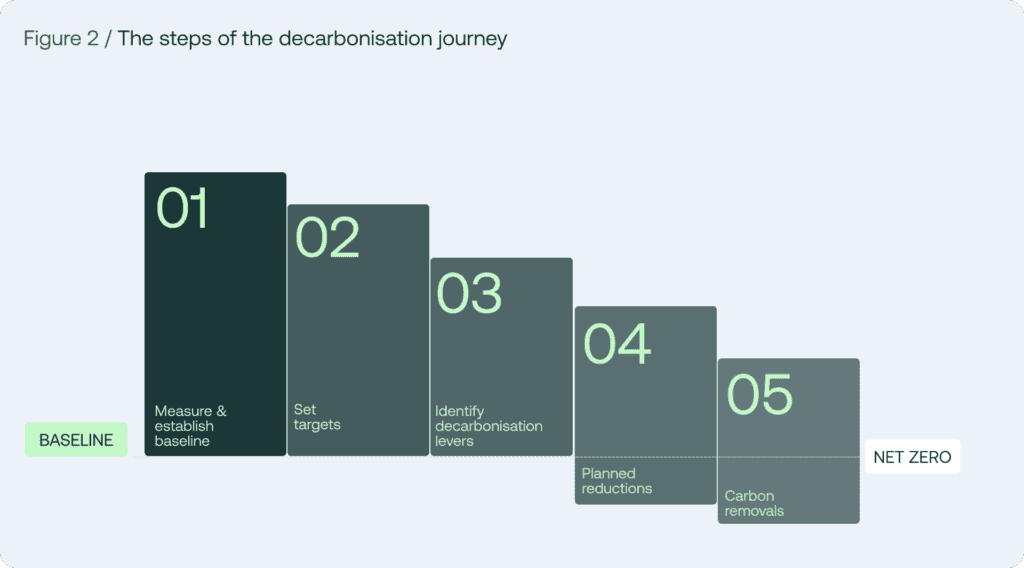 An introduction to corporate sustainability training
An introduction to corporate sustainability training
“Many companies are still unclear about how they’ll achieve climate neutrality and meet the expectations of the Paris agreement by 2050, but the EU’s CSRD serves as a strategic catalyst to structure and inspire their decarbonisation efforts.”
The European Union’s Corporate Sustainability Reporting Directive (CSRD) introduces stringent reporting requirements for large companies in the EU, compelling them to disclose their transition plans towards climate neutrality.
Specifically, the European Sustainability Reporting Standard (ESRS) E1 Climate Change Standard requires companies to disclose their emission reduction targets and detail how they align to limit global warming to 1.5°C. However, for the many companies still unclear on how exactly they will achieve this ambitious target, the new regulation serves as a wake-up call.
And with increased stakeholder pressure – whether from investors, rating agencies, customers or suppliers – the transparency and oversight unlocked by the CSRD promises to kickstart even the most reluctant into action.
Below, find an overview of how the CSRD can help inspire and structure companies’ decarbonisation efforts, becoming a key strategic catalyst for change.
The CSRD: a transparent, harmonised reporting approach to decarbonisation
Here are a few ways CSRD connects with your decarbonisation journey:
Strengthened corporate sustainability reporting requirements
The CSRD requires large companies and publicly listed firms in the EU to provide detailed information on how they operate and manage social and environmental challenges, including decarbonisation efforts. Companies must report on their carbon emissions and reduction targets and the strategies to achieve them.
Increased transparency and accountability
The high level of transparency required to comply with the CSRD ensures that all stakeholders are informed about the sustainability practices of reporting companies. They must provide accurate and verified data on their emissions, holding them accountable for their contributions to climate change and their efforts to reduce emissions.
Standardised reporting
The CSRD aims to harmonise sustainability reporting standards across the EU, with companies required to use standardised metrics for reporting their greenhouse gas emissions. This will make it easier to compare companies’ decarbonisation efforts, giving stakeholders a clearer view of their progress – and enabling them to make more informed choices.
Risk management and financial implications
Under the CSRD, companies must disclose climate-related risks and opportunities, including how these factors impact their business models and financial performance. This may encourage companies to accelerate decarbonisation, which is key in mitigating such risks.
In addition, by linking sustainability and financial reporting, the CSRD ensures that companies consider the financial implications of their decarbonisation strategies – such as the costs of transitioning to low-carbon technologies and the potential for stranded assets.
Corporate strategy and governance
The CSRD helps ensure that decarbonisation becomes a core of corporate strategy and governance. The standards require companies to demonstrate how their sustainability efforts, including emissions reductions, are integrated into their business strategy.
They must also describe the role of the board and senior management in overseeing climate-related issues and decarbonisation efforts, thereby promoting stronger governance and leadership accountability.
Stakeholder engagement
Under CSRD, companies must demonstrate how they engage with stakeholders, including employees, investors, and the community, on issues related to decarbonisation and sustainability. This transparency allows stakeholders to hold companies accountable for their environmental impacts, encouraging them to adopt more ambitious decarbonisation targets.
Innovation and competitiveness
The need to report on decarbonisation efforts may encourage companies to accelerate innovation and adopt new technologies that help reduce emissions. Companies that can effectively manage and reduce their carbon footprint may gain a competitive advantage, as sustainability becomes an increasingly important factor for consumers and investors.
What does the CSRD mean for your company’s net zero transformation?

Ambitious targets
Companies need to set and disclose short-term reduction targets and long-term net zero goals. The Science Based Targets initiative (SBTi) suggests that to achieve net zero, companies need to reduce their own emissions and those of their value chain by 90-95%.
The remaining emissions should be removed through permanent carbon sequestration projects that remove and store CO2 – rather than relying on third-party offset projects such as reforestation.
Transparency on decarbonisation plans and carbon credits
ESRS E1 requires companies to disclose how they are going about tracking and managing emissions and whether they are using carbon credits to achieve climate neutrality – and if so, which ones. This helps to create a distinction between concrete net zero targets and the broader concept of climate neutrality.
Emissions neutralisation, whether achieved through carbon removal, abatement or offsetting to facilitate reductions beyond a company’s value chain, is critical to achieving net zero. However, it is imperative to first prioritise emissions reductions within the company’s value chain.
Value chain integration
Emission reductions must encompass the entire value chain. This requires scrutinising supplier and customer collaborations and redefining offerings with carbon reduction as a core focus.
The net-zero transformation journey: understanding your maturity level
As we have seen, the CSRD is encouraging many companies to adopt a more rigorous approach to decarbonisation. However, there are many challenges to be overcome on the path to climate neutrality. Reaching net zero will require significant changes to business models, supply chains, and product offerings. To achieve such goals, companies need to adopt a strategic approach to their net zero transformation that reflects their current level of sustainability maturity.

Level 1
Your company can accurately measure and report on your emissions – both your own (Scopes 1 & 2) and those of your suppliers (Scope 3 emissions). This requires a Carbon Footprint Assessment to accurately map your organisation’s energy and material use, quantify emissions and assign them to appropriate Scopes as defined by the GHG Protocol.
Level 2
Your company has taken the next step in its climate commitments by setting a science-based (SBTi) target in line with the 1.5°C pathway. Science-based targets provide a clearly defined pathway for organisations to reduce greenhouse gas (GHG) emissions.
Level 3
Once the SBTi target has been set, organisations should prioritise actions based on the climate-related opportunities and risks for their business model and sector. Identifying the areas of your business that are most vulnerable to climate change can inform your strategy and strengthen its resilience. This approach also helps to meet the growing expectations of stakeholders and investors for transparent reporting on climate risks and opportunities.
Level 4
Your organisation is exploring different decarbonisation levers that are appropriate to your operations and value chain. This includes reviewing organisational growth plans, aligning existing and planned climate initiatives, and conducting a gap analysis that compares your organisation’s current trajectory with the target trajectory. In addition, potential decarbonisation options need to be assessed for feasibility and emissions reduction potential.
Level 5
The final stage focuses on facilitated stakeholder engagement sessions. These sessions aim to raise awareness among internal and external teams, increase transparency and secure buy-in across the organisation.
The objective is to foster a sense of shared purpose and to strategically plan the implementation of decarbonisation measures. This involves identifying resources, key actors, and the potential risks, opportunities and impacts of decarbonisation options along the value chain. Climate-focused partnerships are another key strategic lever.
A framework for sustainable change
By improving the transparency and accountability of corporate reporting, the CSRD encourages ambitious climate action. It provides a robust framework to help companies set clear short- and long-term emissions reduction targets – ensuring that their progress is both measurable and comparable.
Beyond compliance, decarbonisation offers key advantages for companies, including cost savings and new market opportunities. It attracts sustainability-focused investors, improves credit ratings, and enhances brand image and customer loyalty.
Additionally, it drives innovation, reduces energy price vulnerabilities, and boosts employee engagement. Ultimately, it future-proofs businesses and aligns them with global sustainability goals.












